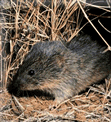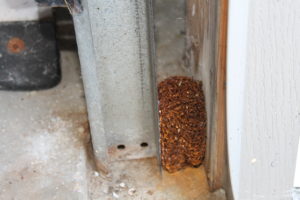The best way to control mice in your home is to keep them from coming in in the first place.
At first glance, our cat, Katy, was an unlikely mouser. She had her first encounter with a mouse at our house when she was 12 years old. Despite having absolutely no claws– when I adopted her, she had been already 4-paw declawed– she somehow killed a mouse that got in the house. I’m not sure how she did it– maybe she batted it to death?
Having a cat is an often-overlooked mouse control option. Now you this doesn’t mean your cat has to kill mice— some sources say they cat’s mere presence in your home, its scent, will ward off mice.
I think the few mice that have made their way into our house over the years regretted it once they realized we had a cat. The last time Katy encountered a mouse she was 18 years old.
That morning, I was jolted awake at 4am by a loud thud– I cautiously exited our bedroom and found Katy crouched in the kitchen, staring intently at the space between the refrigerator and the neighboring cabinet. Looking above where Katy sat, I noticed a cork I’d left on the counter the night before had been chewed–little bits of the cork were scattered across the counter. I felt a little queasy.
I could only assume the thud I heard was Katy chasing a mouse and she couldn’t stop before she crashed into the kitchen cabinets. She never did get that mouse– although some carefully placed mouse traps did. But I’m sure she nearly scared it to death! I like to imagine any mouse that makes it into our house scurrying to get out just as cleverly as they got in.
We said good-bye to Katy this week. She lived to be the ripe old age of 20 years old– which is according to one source, the equivalent of 96 human years. Along with my sadness about her passing, I’ll admit I’m worried that we might see more mice without a cat in our house. I’m convinced she did help keep the mice away.

Our cat Katy in her prime. She was the best clawless mouser there ever was.
Nearly everyone has encountered mice at some point. As gardeners, we unintentionally attract mice to our property with plantings, whether in pots or the ground. Fall is the time of year mice are looking for a nice warm place to spend the winter—this could be the garden, but unfortunately it might be our homes. And you don’t have to live in a rural area to have mice–even a park can be a source of mice.
We have a lot of nature at our back door—woods, farm fields, and our garden. I expect to see mice outside, and maybe in the garage from time to time. And we do. Very occasionally we see a mouse in the garage, put out a trap and catch it. We mostly catch mice, but sometimes we catch voles.

Prairie Vole (Microtus ochrogaster) Photo: U.S. National Park Service
Mice have relatively large ears and tails about the length of the body. Voles have tiny ears, and stubby tails. Mice are always looking for food and shelter and will work at getting to them wherever they are. Voles are not super excited about finding a way into our homes but sometimes end up there if the opportunity accidentally presents itself. They would much rather eat their way through all the plant material in the garden.
As new homeowners, we thought we were doing all the right things to discourage mice—we placed traps and poison baits around the garage in areas that might be attractive to a mouse. We put food sources like bird seed and grass seed in sealed heavy plastic containers.
But mice are sneakier and more stubborn than I thought.
About two years after we moved in, I found mouse droppings and shredded pipe insulation all around our furnace. Mice had gotten into our crawl space, gnawed through the foam insulation on an air conditioner pipe, and slipped into the closet that holds our furnace.
After finding mice in a couple other places indoors we discovered there was a larger problem –one of our crawl space vents had a hole in it. It was like a mouse super highway—any mouse could come and go with ease, and bring all his or her mouse friends along. After we fixed the broken vent, the mice stopped coming in. However, I remained skittish for quite awhile longer!
An electric line installed to run power out into our yard spawned a more recent mouse encounter. The wire passes through a hole in our foundation several inches underground on its way from our house to the yard. It had been there for two years when I noticed something dug the soil away from the hole, which is only slightly bigger than the wiring. I wasn’t sure it was big enough for a mouse to get through, and I got sidetracked chasing my one-year-old son and forgot about it. Big mistake!
Mice can squeeze through a ¼” gap.
Sealing off these gaps is a great way to control mice. Some call this “building them out.” The space around the wires passing through our foundation was enough to allow mice to squeeze through and follow our gas line. They found their way into our home via a gap where the gas line met the fireplace box.
Mice have strong incisors and can chew through many materials, which can make “building them out” a challenge. Some ideas to consider:

A copper kitchen scrubber fits snugly between the garage door track and outer garage wall, blocking entry of any mouse that thinks they want to live in our garage.
- Steel or copper wool. The advantage to using copper is it doesn’t rust. It’s possible to buy a roll of copper wool and cut it to size, but copper kitchen scrubbers work well too. Either steel or copper wool is easily shaped to fit odd spaces. It works perfectly in the gap between my garage wall and the door. Replace as necessary.
- For a more permanent fix, or to prevent the mice from pulling the materials out, mix the steel or copper wool with caulking or spray foam. We have done both methods depending on the location. For extra protection use a sanded caulk that is intended for concrete repair—supposedly mice hate its gritty texture.
Much to my dismay, we didn’t block the gap under our fireplace right away. We knew there were still mice in the crawl space, and they were used to coming up through the space around the gas line. We didn’t want to force them to find a new route into our house, so we trapped them for several days before blocking off their way in with steel wool when we were confident we had gotten them all.
A less efficient option are poison baits.
Poison baits usually contain a relatively low dose of poison in the bait so that the mouse feeds repeatedly and doesn’t avoid the bait because of odd taste or onset of illness.
Not only do the mice have to eat the poison bait repeatedly, but the biggest drawback is that when the mouse dies, you have no control over where it dies. I had read this many times, but after experiencing it firsthand, I have a new respect for this aspect of using poison baits.
One chilly autumn morning I opened our coat closet to grab a jacket. I smelled an odd smell. So did my husband. The closet is adjacent to the door leading out to our garage, where we have poison bait set out for the occasional uninvited mouse guest. Further investigation revealed a dead mouse in the bottom of the closet. I slammed the closet door in horror. How in the world did it get there?
There was no simple way that mouse could have gotten there besides the door to the garage– but there is a big step outside that door, which made me doubt a mouse could find its way inside.
For months I was worried that the mouse had come from elsewhere in the house, which made me flinch every time I opened a drawer or cabinet. But then I read the freaky fact that mice can jump up to 13 inches from the floor to a flat surface, and can climb vertically over a rough surface. That big step was nothing to that little mouse.
We were lucky that dear Katy the clawless mouser never found that mouse before it died in the closet. Mice that have eaten poison baits could potentially harm pets or wildlife that might bite or ingest them.
As disturbed as I was to find a mouse in our house, mice have invaded human dwellings for thousands of years. It’s nothing new. Mice have thrived alongside humans for about as long as there have been humans. Researchers have used mouse populations to document early human migrations. The mice followed the humans—a source of food and shelter. I wonder if any early humans were as scared of mice as I am?
If you liked this post, please subscribe to Grounded and Growing today and receive your copy of “15 Tips to Become a '15 Minute Gardener'” so you can spend less time working ON your garden and more time enjoying being IN your garden.! It’s absolutely free. When you join the Grounded and Growing community, you’ll finally take the garden off your “To-Do” list and allow yourself time to enjoy your garden and savor the peace and serenity there. I tell subscribers about new posts as soon as I hit ‘publish’ and send weekly-ish updates on what’s going on in my garden– good, bad AND ugly.
I never knew that about Katy ❤️ Love that feisty girl